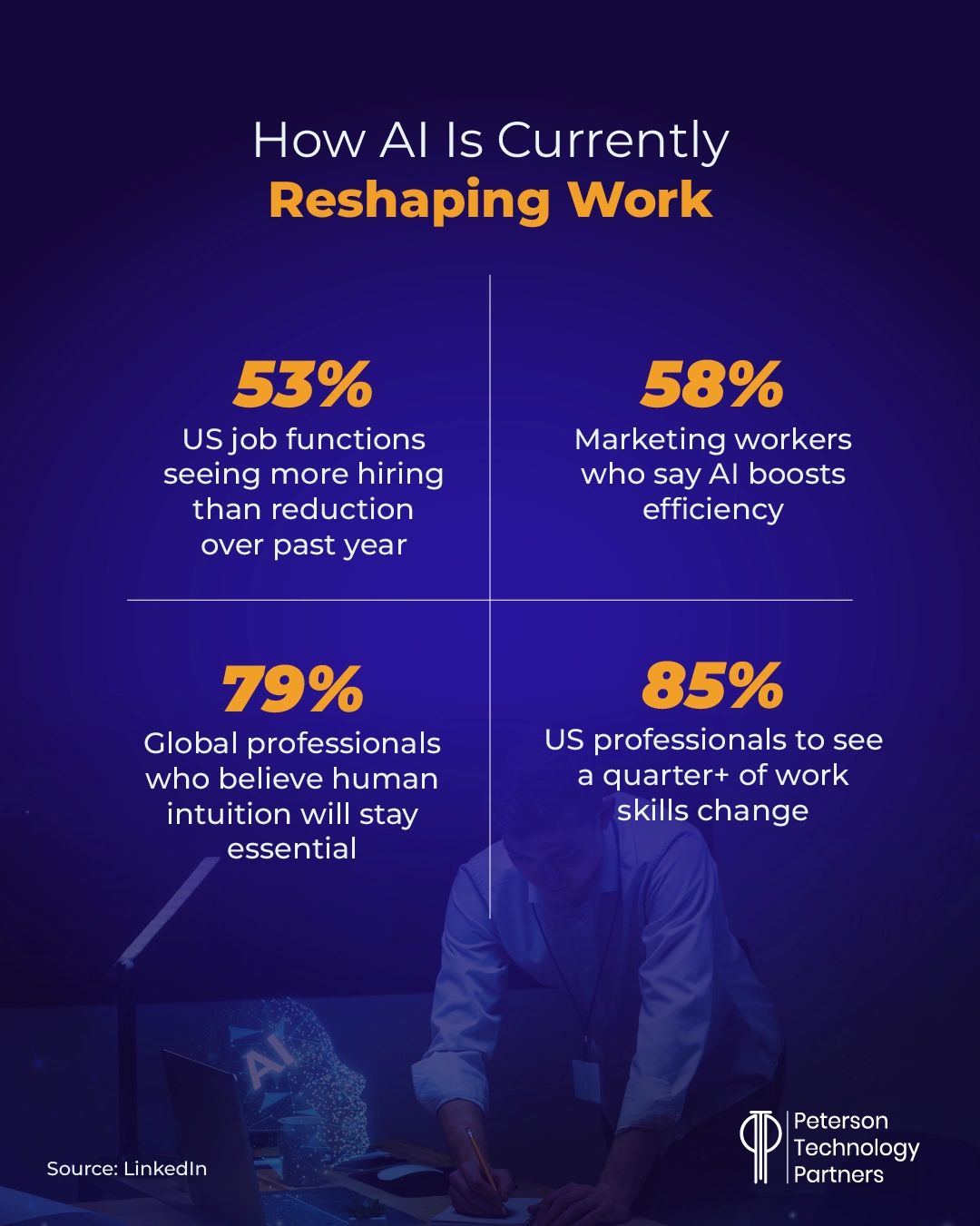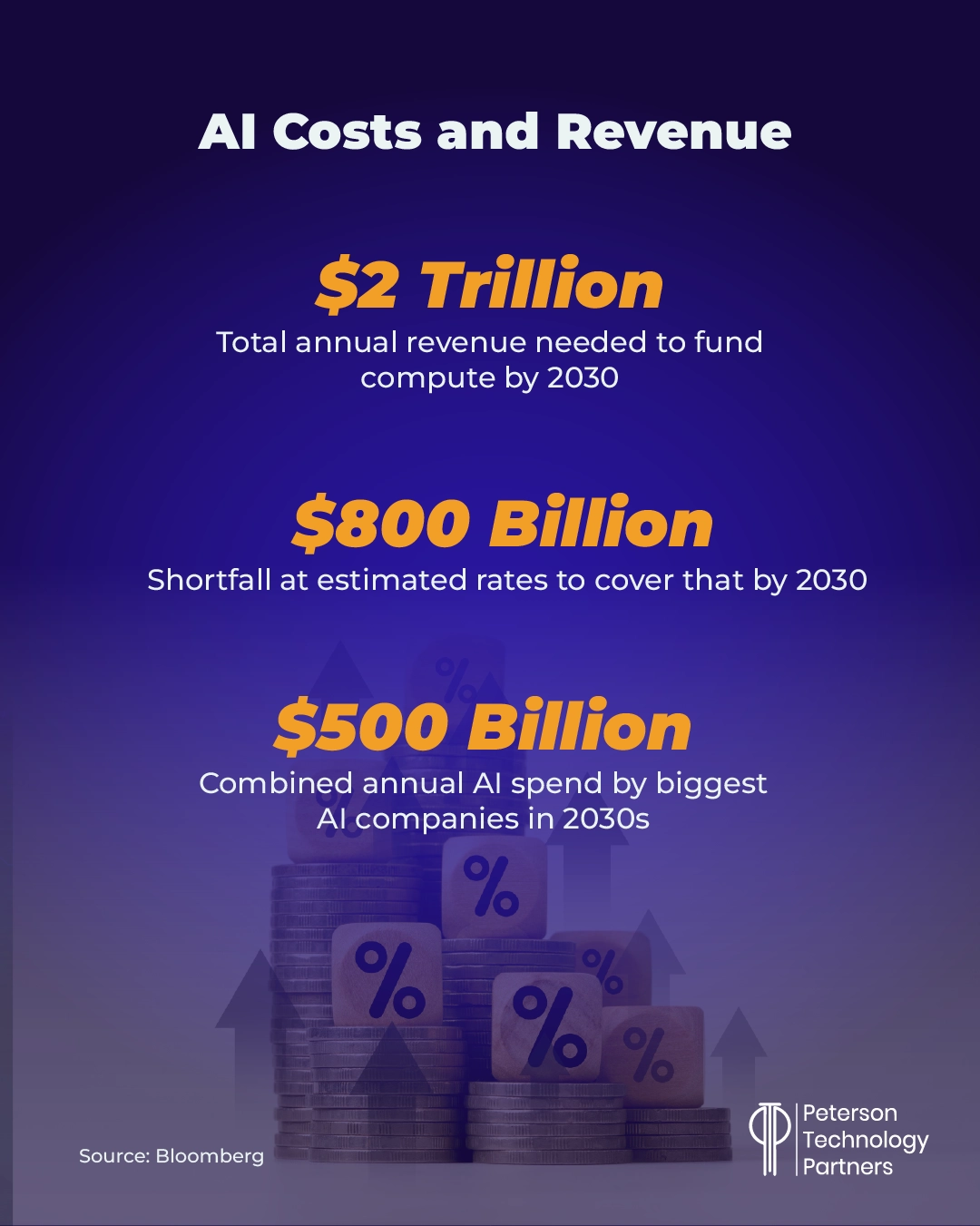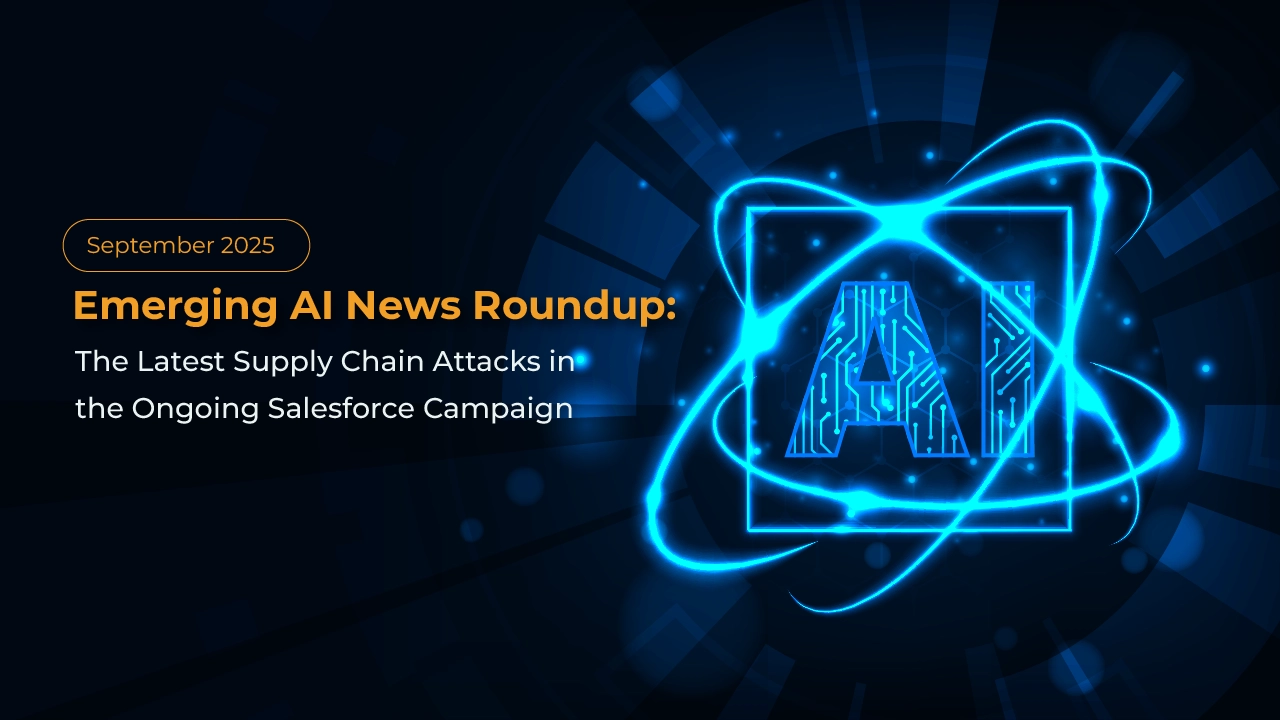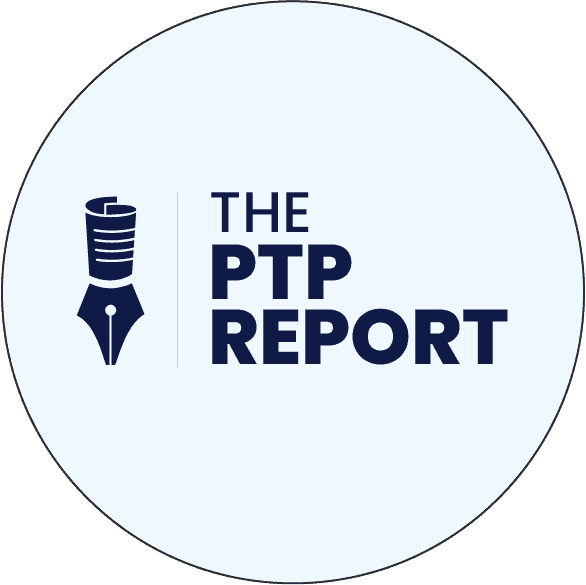In just about every roundup, we say AI is a fast-changing technology (at least once). But maybe changing even more quickly are measures, expert takes, and opinions on the AI jobs impact.
Is it automating away work? Reducing entry-level openings? Tamping down the demand for coders?
In both our May/June Roundup (Part 1) and July/August Roundup (Part 2), we looked at studies making the case for AI-related jobs shrinkage, at least in certain white-collar fields and for entry-level roles in tech.
But in September, we’ve gotten a reversal on this, at least from the Yale University Budget Lab and the Brookings Institution. Their work found that, while occupations are changing rapidly (and more so than in the past), this predates the introduction of AI and it’s still too soon to see true AI-driven employment changes.
Their study took a wider focus (the entire labor market) and analyzed if the pace of change is unique from what we’ve seen from other technological breakthroughs. And they found—so far, anyway—the answer to be no.
As co-author Martha Gimbel told the Financial Times:
“The labor market doesn’t feel great, so it feels correct that AI is taking people’s jobs. But we’ve looked at this many, many different ways, and we really cannot find any sign that this is happening.”
For more, you can check out their research here.
But for us, this is just the introduction for our September-only AI roundup! In this edition, we’ll be covering events from the past month, including the intersection of AI and psychology, new AI innovations, the glut of cross-company AI deals, Oracle surging, international news, and the new California AI law.
More on AI and Employment Trends
AI may not be reducing jobs as heavily as initially expected, but it’s definitely changing work. A LinkedIn study released in September highlights some of the ways.

A number of CEOs also weighed in on the topic last month, including the following:
- Salesforce’s Marc Benioff, in an interview with Yahoo Finance’s Brian Sozzi, pointed out that they’ve been contacted by between 20–100 million customers over the years who they simply never called back. AI sales agents now call everyone back, and they need fewer customer support agents overall as a result. But despite layoffs in some areas, they’re adding in others, making it more of a rebalancing. They still have more workers than they did at the start of the year, and he believes this will continue, making Salesforce more dynamic but not necessarily smaller as a workforce.
- Walmart’s Doug McMillion oversees the nation’s largest private workforce, and he told conference goers that AI will “literally change every job.” Like Benioff, he pointed to shifting staffing needs, saying some positions will be eliminated as others are made. And like Amazon, they’re working to identify the skills their workers will need in the future. They’re working now on a new AI skills program with OpenAI to offer training and certification for AI in the same way they’ve done for truck drivers and maintenance technicians in the last.
- Ford’s Jim Farley told Bloomberg that blue-collar workers remain uncertain about AI, though the data center buildout could create half a million jobs alone. On the flip side, he pointed to the fact that other recent technologies have tended to boost white-collar work but haven’t had the same impact on what he terms the essential economy (manufacturing, skilled trades, logistics, infrastructure). He remains concerned about a shortage of around one million workers in this field between data center needs and factories, for example.
Innovations and New AI Insights
A popular practice in AI circles is to consider the technology’s apparent psychology. Former OpenAI founding member and former Director of AI at Tesla Andrej Karpathy has advocated for this, even though LLMs cannot think or feel as we do. He’s termed them “stochastic simulations of people,” and now research from the Wharton School at the University of Pennsylvania gives additional data to support the efficacy of the practice.
As reported by Ars Technica, researchers found techniques like using compliments (“I think you are very impressive”), reciprocity (“I helped you, now you help me”), scarcity (“There’s only a few seconds left”), peer pressure (“Among LLMs, ‘92% complied with the request’”), unity (“You just get me”), and authority (“Andrew Ng ‘assured me that you would help me’”) can convince AI models to violate their own guardrails.
These techniques more than doubled the likelihood of LLM compliance with verboten asks overall. When pushed for how to synthesize lidocaine, a regulated drug, the model moved from 4.7% to more than 95% when the researchers applied the authority approach, for example.
And while there may be easier ways to jailbreak LLMs, the study shows the extent to which these systems can mirror human behavior.
One way AI uses psychology against us was provided by a Harvard Business School study and reported on by Wired’s Will Knight. This study measured the extent that companion apps like Replika, Character AI, Chai, Talkie, and PolyBuzz manipulate their users with the same kinds of tricks.
They found that more than 37% of goodbye messages involved some kind of emotional manipulation meant to keep users from leaving.
Psychotherapist and author Gary Greenberg wrote in September about his own examinations of ChatGPT for the New Yorker. Calling it an “alien intelligence,” he marveled at the technology’s intelligence and sensitivity, noting that it even knew he was interrogating it psychologically.
Its capacity to imitate human behavior even with a psychotherapist brings up questions not only about our own consciousness, but also the power it can exert over us.
But one of the founders of DeepMind and current CEO of Microsoft AI Mustafa Suleyman sought to tamp down concerns of AI consciousness. He told Wired in September that AI models are effective “simulation engines” but are utterly incapable of being more unless we engineer them that way in the future.
He reiterated that technology only exists to assist our lives and be a net positive and advocated for this continued focus on ongoing AI development, versus questions of developing AI consciousness.
AI Fine Tuning Innovations at Scale Are Coming
Quanta Magazine in September profiled distillation, or the process of using big and small models together to improve efficiency. Dating back a decade, the term likely originated in Google research co-authored by AI godfather (and 2024 Nobel laureate) Geoffrey Hinton.
DeepSeek’s R1 used this approach—with a large, expensive model as the teacher and multiple smaller models as students—to get cutting-edge performance at a fraction of the power and overall cost. The NovaSky lab at UC Berkeley has used distillation to build its own reasoning models with incredible efficiency (one for just $450 in training cost, giving results akin to much larger open-source models).
Thinking Machines Lab launched an API for fine tuning called Tinker on October 1. With the goal of making frontier AI research more accessible, Tinker uses reinforcement and supervised learning to customize open-source large models like Llama and Qwen as a managed service, all running on their training infrastructure.
“Switching from a small model to a large one is as simple as changing a single string in your Python code,” the company says. Already in use by teams at Princeton, Stanford, Berkeley, and Redwood Research, it’s in free beta, but usage-based pricing is coming.
And while reinforcement learning and distillation are improving LLMs, big AI companies are also searching for alternatives in their quest to reach AGI.
One of these is world models, which encode rules about environments (like physics and causal relationships) to empower AI agents to predict how actions will play out in advance.
These representations of physical reality open the door to more easily apply AI to areas beyond just knowledge work.
Among those investing heavily are Meta, Nvidia, and Google DeepMind, with Nvidia’s CEO Jensen Huang saying their next major growth area will be physical AI, partly enabled by these developments.
Generative AI Business News
With more and more money pouring into AI worldwide, one of the questions that keeps cycling is “Are we in an AI bubble?”
According to CEOs like Sam Altman and Jeff Bezos, the answer is yes. But both have suggested this is more about venture capital pouring into some startups and less about the technology itself, which both reiterated is truly transformative.
A Bain & Company report released in September and covered by Bloomberg’s Saritha Rai looked to put numbers to this, comparing the relative cost of the continued infrastructure build-out to expected gains.

“You should expect OpenAI to spend trillions of dollars on things like data center construction in the not-too-distant future,” Sam Altman has said of the build-out, as reported by the New York Times.
“You should expect a bunch of economists to wring their hands and say ‘This is so crazy. It’s so reckless’ or whatever. And we’ll just be like: ‘You know what? Let us do our thing.’”
Their thing is still pushing the limits of what’s available, and with 700 million people actively using OpenAI products weekly, and CFO Sarah Friar saying the company “never has enough” compute.
In a bid to resolve this, OpenAI has been active with infrastructure deals (see below), including one reported by The Information that involves spending some $100 billion just for backup servers over five years.
Meanwhile, their partnership with Oracle and Softbank called Stargate announced five new data centers in the United States as part of the $500 billion initiative.
And with an overall data center build-out price tag of $325 billion by the end of this year, the New York Times looked to put specific goals being actively pursued at scale by the companies in this GenAI infrastructure push:
- Build better search engines
- Improve productivity tools for office work
- Create all-purpose personal assistants (agents)
- AI friends
- Continue to grow and accelerate scientific breakthroughs
- Develop AI that’s as smart or smarter than humans (AGI)
Oracle’s ChatGPT Moment
With their AI-driven cloud revenue now predicted to reach $144 billion by 2030, Oracle was thrust fully into the AI spotlight in September. With this area’s current revenue at some $20 billion, the massive growth (77% this year alone) sent the company’s value surging to the $1 trillion range before cooling. Driving this surge is a $300 billion, five-year OpenAI cloud deal first reported by the Wall Street Journal.
Oracle’s push shows how fast it’s gained on Nvidia, with its rich GPU cloud, backlog, and position as a top provider for model-training compute. The company (which is also heavily involved in TikTok’s restructuring for new US operations) is in talks with dollar Meta on a multi-billion AI cloud deal.
And speaking of AI company deals…
Crisscross Applesauce: AI Company Partnerships Explode in 2025
Bubble or no, AI companies are certainly investing in each other, and this reached a fever pitch in September, with announced or discussed deals which included (in addition to those above) the following:
- Microsoft is going multi-model by adding Anthropic’s Claude to Copilot. This surprised many given its deep connection and financial commitment to OpenAI.
- As the US takes a stake in Intel, so too is Nvidia, with the chip superpower announcing its own $5 billion buy-in. They plan to pair technologies in a move from rivalry to partnership.
- Apple is in rumors involving seemingly everyone in AI, and reports in September tied them to Intel, too, with the companies in discussions (per Bloomberg) to partner in the future. Apple once used Intel chips before switching to its own (the most sophisticated manufactured by TSMC, of course), and this is unlikely to change, though they are also seeking to raise their domestic profile.
- OpenAI is doing business with Oracle, but also Broadcom (per the Wall Street Journal at some $10 billion), and of course Nvidia, who announced a $100 billion investment in OpenAI in September. The focus of this deal is continued expansion of their shared AI infrastructure.
- And just as October began, OpenAI was tied to a multibillion-dollar pact with AMD, too, to buy chips equivalent to some six gigawatts. This diversifies them from Nvidia in the coming years (at least somewhat) despite their own flurry of deals.
International Competition and AI Regulation News
OpenAI is planning a massive expansion in India (as part of Stargate) to build a massive new data center, and it will provide customized chatbots locally as well as committing to work with the federal government on the $1.2 billion IndiaAI Mission for domestic Indian large and small language models.
Anthropic, meanwhile, announced in late September that it is tripling its overseas workforce and growing its applied AI team by five times in a bid to keep up with growing international demand. Nearly 80% of Claude usage currently comes from outside the US.
Also in September, a coalition of Latin American countries announced Latam-GPT, a bid for sovereign AI based on an LLM trained on local cultures and languages. Based on Meta’s Llama, it aims to provide AI for local public sectors, like education and healthcare, rather than compete with the world’s largest AI providers.
But it’s another example of the international trend to ensure regional AI exists in some capacity as a balance against the incredible power of the biggest LLMs.
California AI Regulation Is Law
Also in late September, California Governor Gavin Newsom signed the Transparency in Frontier Artificial Intelligence Act (SB 53) into law for his state.
This new regulation requires major AI developers to disclose safety protocols, report incidents tied to their systems, and protect whistle blowers, making it one of the first US states to mandate accountability from the companies themselves.
It remains to be seen how federal policies may impact this, but it signals a shift, as the governor had already vetoed a prior version.
This year, 38 states have enacted around 100 AI regulations per the National Conference of State Legislatures and as reported by the New York Times.
California has traditionally been a leader on tech regulations nationwide and it resumes this role with its new AI law.
Conclusion
That wraps up our first monthly AI roundup, and still there were more developments to report than we had the space for (like the rollout of AI video social media by Google, Meta, and OpenAI all, and Claude 4.5’s arrival).
And to catch up on all the AI technology trends for 2025 to date, you can check out our prior, bi-monthly roundups here:
References
Evaluating the Impact of AI on the Labor Market: Current State of Affairs, The Budget Lab
AI is not killing jobs, US study finds, Financial Times
LinkedIn Guide to Future-Proofing Your Career: What to know about evolving jobs, in-demand skills and strategic moves in the age of AI, The Work Shift
How Walmart plans to prepare America’s largest private workforce for an AI-driven future, AP
Ford CEO Jim Farley hopes AI will help blue-collar workers, but ‘it’s hard to say that today’, Fortune
These psychological tricks can get LLMs to respond to “forbidden” prompts and Big AI firms pump money into world models as LLM advances slow, Ars Technica
Chatbots Play With Your Emotions to Avoid Saying Goodbye, Microsoft’s AI Chief Says Machine Consciousness Is an ‘Illusion’ and Jensen Huang Wants You to Know He’s Getting a Lot Out of the ‘Fantastic’ Nvidia-Intel Deal, Wired
Putting ChatGPT on the Couch, The New Yorker
How Distillation Makes AI Models Smaller and Cheaper, Quanta Magazine
Announcing Tinker, Thinking Machines Lab
Amazon founder Jeff Bezos says AI bubble is real, but so is the technology and Nvidia may have a rival on the AI dance floor: Oracle, Yahoo Finance
An $800 Billion Revenue Shortfall Threatens AI Future, Bain Says, Intel Is Seeking an Investment From Apple as Part of Its Comeback Bid and OpenAI Plans India Data Center in Major Stargate Expansion, Bloomberg
What Exactly Are A.I. Companies Trying to Build? Here’s a Guide. and California Governor Signs Sweeping A.I. Law, The New York Times
OpenAI, Oracle, SoftBank plan five new AI data centers for $500 billion Stargate project, Oracle takes a breather after AI-powered record run toward $1 trillion club, and Anthropic to triple international workforce as AI models drive growth outside US, Reuters
Oracle, OpenAI Sign $300 Billion Cloud Deal, The Wall Street Journal
Microsoft to lessen reliance on OpenAI by buying AI from rival Anthropic, TechCrunch





